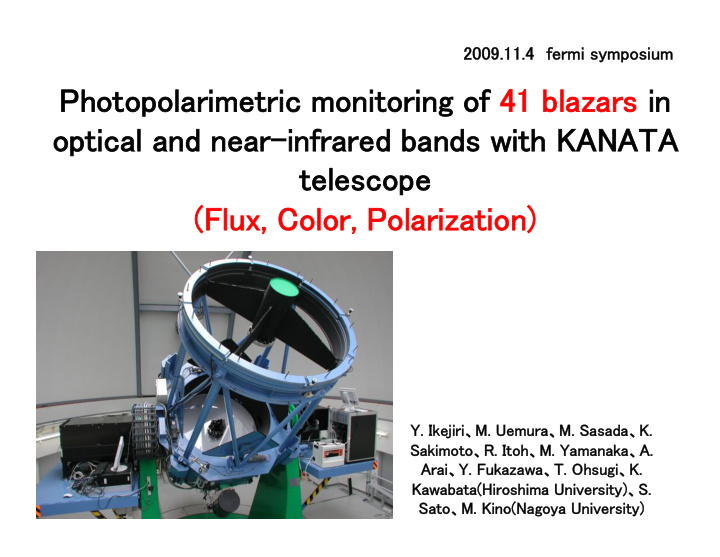



2009.11.4 fermi symposium Photopolarimetric monitoring of 41 blazars in optical and near-infrared bands with KANATA telescope (Flux, Color, Polarization) Y. Ikejiri、M. Uemura、M. Sasada、K. Sakimoto、R. Itoh、M. Yamanaka、A. Arai、Y. Fukazawa、T. Ohsugi、K. Kawabata(Hiroshima University)、S. Sato、M. Kino(Nagoya University)
Class of Blazars LBL IBL HBL optical band Inoue et al. 2009 The peak energy of synchrotron emission : Lower than optical region ⇒ LBL (Low-energy peaked BL Lac object) Optical region ⇒ IBL (Intermediate-energy peaked BL Lac object) Higher than optical region ⇒ HBL (High-energy peaked BL Lac object) We discuss the characteristics of each class.
Previous works about color and polarization Flux & Color of 3C 273 brighter magnitude in V Relationship between flux & color Some of blazars tend to be bluer-when-brighter. The Flux varies by injection of high energy electron? ⇒Common feature in ALL blazars??? bluer Dai et al. 2009 Color (V-R) Relationship between flux & Flux & P.D. of OJ 287 Polarization Degree (P.D.) P.D Erratic or Systematic??? ⇒Poorly studied in optical magnitude in R Yu et al. 2002 We investigated the correlation of Flux, Color and Polarization, using the KANATA telescope.
KANATA telescope KANATA 1.5m Optical and near-infrared telescope in Higashi-Hiroshima Observatory • KANATA of Hiroshima-Univ. ⇒We can perform observations Flexibly, Frequently and for a Long period. • TRISPEC can do simultaneous photopolarimetory in the Optical (V) and near-infrared (J) bands. KANATA and TRISPEC are good tools for the observation of blazars. We performed follow up observation with Fermi!!
Monitoring list Monitoring observations Total : 41 started on May 2008. Detected by Fermi Some results : Sasada+08, Sasada+09 3EG 1052+571 MisV 1436 PKS 1222+216 1ES 0323+022 QSO 0324+341 Mrk 421 PKS 1502+106 1ES 0647+250 Mrk 501 PKS 1510-089 1ES 0806+524 OJ 287 PKS 1749+096 1ES 1959+650 OJ 49 PKS 2155-304 1ES 2344+514 ON 231 QSO 0454-234 3C 371 ON 325 QSO 0948+002 3C 454.3 OQ 530 QSO 1239+044 3C 66A PG 1553+113 RX J1542.8+612 3C 273 PKS 0048-097 S2 0109+22 3C 279 PKS 0215+015 S4 0954+65 AO 0235+164 PKS 0422+004 S5 0716+7143 BL Lac PKS 0754+100 S5 1803+78 H 1722+119
Correlation of Flux and Color (V-J)
Examples of light curves 3C 371 3C 454.3 brighter bluer bluer-when-brighter redder-when-brighter Flux & Color of 3C 454.3 brighter The thermal emission of an accretion disk can be seen when the emission of the jet becomes weak. The objects showing a redder-when-brighter trend. ・3C 454.3 ・PKS 1510-089 ・QSO 0454-234 bluer
Correlation of Flux & Color Objects observed in more than 10 nights: N obs > 10 ⇒ 29/41 The number of objects which have ・・・ Bluer-when-brighter ・significant correlation : 24 (83%). brighter -bluer-when-brighter 21 Absolute mag. in V -(redder+bluer)-when-brighter 3 ・no correlation : 5 (17%). Color (V-J) bluer The “bluer-when-brighter” feature is common observed in 83% blazars.
Luminosity & Color(V-J) “ bluer-when-brighter ” objects Absolute magnitudes and Color of all objects steeper Gradient ⊿Flux/⊿Color brighter Absolute mag. in V steep shallow brighter Color (V-J) redder Absolute mag. (average) ・HBLs tend to be faint and have small gradient. ・The variation amplitudes of color are also small in HBLs, too. The faint blazars (=HBLs) show less variability than LBLs.
Correlation of Flux and Polarization Degree (P.D.)
Correlation of Flux & P.D. N obs > 10 ⇒ 29/41 Objects observed for more than 10 nights: The number of objects which have ・・・ ・significant correlation: 14 (48%). AO0235+164 (4 objects show P.D. [%] negative correlation.) ・no correlation: 15 (52%). magnitude in V Poor correlation of Flux & P.D., compared with that of Flux & Color
Luminosity & P.D. absolute magnitudes and P.D. about all blazars higher There is no objects. ・There are two type of LBL: P.D. [%] ・large variation amplitude ・small variaion amplitude ・The P.D. of faint blazars (=HBLs) are always low. Absolute mag. in V brighter The faint blazars (=HBLs) have low P.D. and show small amplitudes of P.D..
Implication of the observations The results of the observations ・ “ Bluer-when-brighter ” : common feature in blazars ・The faint blazars (=HBLs) have the small variation amplitudes of Flux, Color and P.D.. LBL: observed above cut off of synchrotron emission HBL: below Injection of high energy electrons Variation of beaming factor ν F ν less variable variable variable optical band In the case of HBL LBL ν In blazars, most of flare is caused by the injection of high energy electrons.
Summary ●Correlation • The correlation of the Flux and the Color ⇒ 24/29 (83%) • The correlation of the Flux and the P.D. ⇒ 14/29 (48%) (positive correlation: 10 (34%), negative correlation: 4 (14%)) ●Variability in each class • The faint blazars (=HBLs) have the small amplitudes of Flux, Color and P.D.. Future works ・ More detailed analysis of Polarization ・ The correlation of the gamma and the optical ⇒ under investigation Latest observations can been in “KANATA Obslog” http://kanatatmp.q.atena.ne.jp/kanataobslog/
Recommend
More recommend